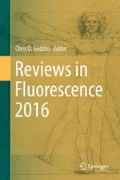Abstract
This chapter is the first of a series introducing fluorescence techniques for scientists just beginning to use them. They are written for students and early career investigators, particularly in the life sciences who may have only a modest background in physics and chemistry. This chapter introduces the basics of fluorescence techniques, including the fundamentals of spectra, the Golden Rules, and an introduction to fluorescence instruments and experiments. A glossary is included.
Access this chapter
Tax calculation will be finalised at checkout
Purchases are for personal use only
Summary
This article summarizes the basics of the fluorescence phenomenon, spectra, the Jablonski Diagram, and the Golden Rules.
Author information
Authors and Affiliations
Corresponding author
Editor information
Editors and Affiliations
Glossary
- Absorbance, Absorbance Spectrum
-
Classically, a molecule will absorb light energy through a resonant process when the plane orientation and frequency of the oscillating electric field of incident light are close to or match those of a characteristic transition dipole of the molecule, such as S0 to S1. The efficiency of the absorbance is expressed as a molar extinction coefficient ε, specified at a particular wavelength λ. The absorbance spectrum is the variation of the extinction coefficient with wavelength.
- Emission, Emission Spectrum
-
The emission spectrum expresses how the intensity of fluorescence varies with wavelength: it is measured by exciting at a fixed wavelength that the fluorophore absorbs, and measuring the intensity as the wavelength transmitted by the emission monochromator is scanned over some range.
- Excitation, Excitation Spectrum
-
The excitation spectrum is the converse of the emission spectrum: one varies the excitation wavelength and measures intensity at a fixed emission wavelength. Since the molecule must absorb to fluoresce, the 3rd Golden Rule states the excitation spectrum is usually congruent to the absorbance spectrum (but the units differ).
- Excited State
-
A molecule or atom enters an excited state when it absorbs energy somehow, such that an electron (usually a valence electron) jumps from a lower to a higher energy orbital. For typical fluorescence experiments with UV to IR wavelengths of absorbance and emission, the energy differences between ground (q.v.) and excited states are large enough that at mild temperatures (c. 300 K) the excited states are not populated thermally.
- Fluorescence
-
Phenomenon whereby a molecule or atom in an excited state after absorbing a photon loses that energy by emitting a photon of longer wavelength.
- Fluorophore
-
Generic term for an atom, ion, molecule, or portion of a molecule that is capable of fluorescing.
- FRET, Förster resonance energy transfer
-
Resonant, non-photon mediated energy transfer from an excited molecule (usually a fluorophore) to a second molecule whose absorbance roughly matches the first molecule’s emission wavelength; the efficiency of the transfer depends on proximity, wavelength overlap, relative orientation of the molecules, and other factors.
- Ground State
-
Lowest energy state of a molecule; often but not always, the ground state is a singlet.
- Internal Conversion
-
Rapid (picosecond) relaxation from upper level excited states to the lowest excited state of the same multiplicity (e.g., singlet or triplet).
- Jablonski Diagram
-
Diagram that schematically depicts energy levels and transitions between them; see Fig. 1.1.
- Monochromator
-
An optical device that takes a collimated beam of light as input and emits a beam with only a small portion of the incoming wavelengths; usually the center wavelength can be varied over several hundred nanometers, and the bandwidth can often be varied as well.
- Photon
-
A quantum mechanical “packet” of light energy.
- Spectrum
-
The distribution of light energy over a range of wavelengths.
- Wavelength
-
Classically, the distance peak-to-peak of electromagnetic waves; sometimes denoted as λ. For green light, the wavelength is approximately 500 nanometers, or 0.5 micrometers.
Rights and permissions
Copyright information
© 2017 Springer International Publishing AG
About this chapter
Cite this chapter
Thompson, R.B., Scarlata, S. (2017). Fluorescence Made Easier: Fluorescence Techniques for the Novice. Episode 1: The Basics. In: Geddes, C. (eds) Reviews in Fluorescence 2016. Reviews in Fluorescence. Springer, Cham. https://doi.org/10.1007/978-3-319-48260-6_1
Download citation
DOI: https://doi.org/10.1007/978-3-319-48260-6_1
Published:
Publisher Name: Springer, Cham
Print ISBN: 978-3-319-48259-0
Online ISBN: 978-3-319-48260-6
eBook Packages: Biomedical and Life SciencesBiomedical and Life Sciences (R0)

